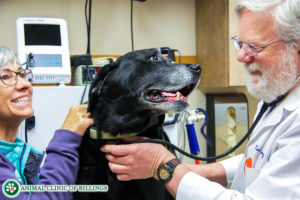Perineal Hernia
A hernia is an abnormal protrusion of tissue through a gap in the surrounding muscle and/or connective tissue. A perineal hernia occurs when tissue slips between the muscles that support the rectum (pelvic diaphragm) and into the space beneath the skin adjacent to the rectum. The tissues most commonly involved are the rectum and pelvic fat, although other organs such as the bladder, descending colon, small intestine, and prostate, can also protrude into a perineal hernia.
What are the causes?
There are several possible causes of perineal hernias. Increased intra-pelvic pressure from conditions that cause straining, such as chronic constipation, prostate disease, bladder inflammation, urethral obstruction, colitis, and inflammatory bowel disease, may result in weakening of the pelvic diaphragm and subsequent hernia formation. Because intact males are much more commonly affected than neutered males and females, it is thought that male hormones may play a role in the development of perineal hernias. Alternatively, prostate issues that tend to occur in intact males may cause straining that ultimately results in hernia formation.
Which dog breeds are predisposed and what are the symptoms?
Perineal hernias are most common in middle-aged and senior intact male dogs, and are rarely seen in cats. The most commonly affected breeds include Boston Terriers, Boxers, Welsh Corgis, Collies, Old English Sheepdogs, Pekingese, Poodles, and Dachshunds. When a cat has a perineal hernia, it is most commonly associated with megacolon, a condition where the colon becomes weakened and dilated, resulting in chronic constipation and straining.
The most common symptoms of a perineal hernia in dogs and cats are a bulge or swelling beside the rectum, constipation, and straining to defecate. Other symptoms include painful defecation, fecal incontinence, altered tail carriage, and straining to urinate. Hernias occur more commonly on the right side, and in more than 30 percent of cases, another hernia will eventually form on the opposite side.
How is a perineal hernia diagnosed?
Diagnosis is usually relatively straightforward based on history and physical examination of the dog or cat. A rectal examination and palpation on the pet is necessary to assess the pelvic diaphragm musculature. Once a perineal hernia has been confirmed, it is important to search for an underlying cause, such as an enlarged prostate or intestinal disease, as this must also be addressed to reduce the risk of recurrence or future herniation on the opposite side.
What are the treatment options?
If the clinical signs and symptoms associated with a perineal hernia in dogs and cats are minimal. In most cases, conservative treatment is an option but is still rarely successful in fully controlling the clinical signs of a perineal hernia long term. Conservative therapy of a perineal hernia for dogs and cats would include a high fiber and/or moist diet, one or more stool softener, and may require manual removal of impacted feces.
Surgery is the treatment of choice for a perineal hernia. Castration at the time of the hernia repair is necessary for all intact males to eliminate the hormonal influences that cause prostate enlargement and weakening of the pelvic diaphragm. The risk of a recurrence is much higher in dogs that are not castrated along with their hernia repair.
During repair of a perineal hernia, an incision is made adjacent to the rectum on the affected side, the herniated contents are moved back to their correct locations, and the opening through which they moved is closed using suture as well as a muscle flap and/or surgical mesh if necessary. If the bladder or descending colon are involved in the hernia, an abdominal incision must also be made in order to reposition these organs and tack them into place so they will not move out of position in the future. Some surgeons prefer to include an abdominal approach with all perineal hernia repairs, in order to ensure the correct positioning of all involved tissues.
What is the post-operative care?
The surgical incision, adjacent to the rectum, needs to be kept clean and dry. A course of antibiotics will be dispensed due to the elevated risk of contamination in this location. Stool softeners and a low residue diet will be prescribed for several weeks to prevent straining and increased pressure that could result in breakdown of the repair. The most common complications are surgical site infection and recurrence of the hernia.
Perineal Hernia Frequently Asked Questions:
How long will my dog or cat need to stay in the hospital?
Most commonly, pets will stay the night after a perineal hernia procedure and be discharged the following day.
Is castration necessary?
Yes. Perineal hernias are primarily encountered in intact males and castration will reduce the size of the prostate and remove the hormonal influence on the pelvic diaphragm. Most veterinarians consider castration to be necessary, as the recurrence rate is much higher in animals that are not castrated.
When is a perineal hernia considered an emergency?
Occasionally, the bladder can become entrapped in a perineal hernia, and the pet may not be able to urinate. Similarly, loops of intestine can become entrapped in the hernia resulting in a blockage of blood flow. Either of these scenarios necessitates immediate veterinary attention

Let our highly trained and experienced team of veterinarians and veterinary technicians help you keep your cat as happy and healthy as they can be.
Call the Animal Clinic of Billings and Animal Surgery Clinic to schedule your pet cat’s next wellness examination with one of our veterinarians today!
406-252-9499 REQUEST AN APPOINTMENT



